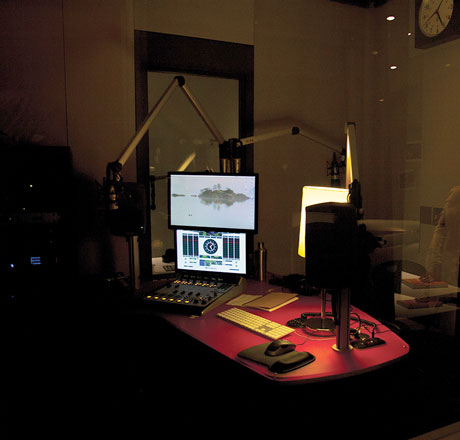INTERVIEW - July, 2018
Ira Glass’ American Life
WRITER: C. C. CLARK
REPORTERS: Sabine Lloyd, Lily Baldwin, Kylar Flynn, Brandon Lopez, Kyle Austin, Simone Harper, Angie Gonzalez, Jacqui Martin, Lauren McKechnie, Claire McKechnie, Samantha Michaels, Josh Santos, Anna Silverman, Campbell Slavin, Lilli Wanninger
“From WBEZ Chicago it’s This American Life, I’m Ira Glass...stay with us.”
 On the surface this unremarkable sentence provides the bare minimum of information and nothing but: radio station, title, host. And yet whenever we hear those nine words—whether it’s on the bedroom radio, through headphones on the bus, or anywhere in between—a sense of calm washes over us.
On the surface this unremarkable sentence provides the bare minimum of information and nothing but: radio station, title, host. And yet whenever we hear those nine words—whether it’s on the bedroom radio, through headphones on the bus, or anywhere in between—a sense of calm washes over us.
Perhaps it’s the familiarity of the delivery that’s so soothing. The pauses and intonations are always the same, and when we hear this exact and particular series of soundwaves, our senses alert us that we’re about to hear stories that will make us think, laugh, or cry—sometimes all three at once. But the thing we love most about that sentence? “Stay with us.” It’s an ongoing invitation to take an unforgettable journey into the challenging lives of complex people not unlike ourselves. And in that spirit we invite you to peer into the life of the show’s erudite host, Ira Glass. From Marin County, California, it’s FastForward…stay with us.
This American Life's office is unlike your typical workplace in that there’s something about it that’s just cozy—the hallways, rooms, and offices are furnished with comfy couches and chairs, and there are books, posters, and awards everywhere. It’s an atmosphere that encourages a sense of togetherness, a feeling that important work can be accomplished in a creative, interesting and unique way.
Glass joined us around a low table and began by telling us what he thinks makes This American Life unique. “The stories are narratives in the most traditional sense. They’re stories like a story on TV: not like journalism, but structured to be like a movie…There’s characters and a situation, dramatic stuff happens to them, surprising stuff happens to them, they have feelings about it, they have thoughts about it.” Telling true-life stories within a traditional narrative structure not only makes an everyday story more interesting, it takes on a richer sense of life and feeling when told from the perspective of the person who experienced it.
 Recently, This American Life transitioned into covering news events as well, but through their signature narrative-based personalized lens. Since any person’s individual story is more compelling than a fact sheet, this approach provides an entirely new dimension to the day’s news. One example is a story the show did about refugee camps in Greece. “I felt really glad that the audience couldn’t see the people in the stories, because if you saw them…it just looks like pictures you’ve seen in the newspaper…Whereas when you hear somebody say ‘So here we are, we’re in Turkey, we’re going to get in this little raft and my kids are crying and we know a lot of these rafts sink and here’s what I had to say to talk my kids into getting on the raft with me, here are the lies I told my own children to convince them to get on the raft that brought us over to Greece’—it’s so much more personal. You just cut through a lot of the clutter and just get to a thing that’s emotional and relatable. And I have to say, that’s the special unique power of radio.”
Recently, This American Life transitioned into covering news events as well, but through their signature narrative-based personalized lens. Since any person’s individual story is more compelling than a fact sheet, this approach provides an entirely new dimension to the day’s news. One example is a story the show did about refugee camps in Greece. “I felt really glad that the audience couldn’t see the people in the stories, because if you saw them…it just looks like pictures you’ve seen in the newspaper…Whereas when you hear somebody say ‘So here we are, we’re in Turkey, we’re going to get in this little raft and my kids are crying and we know a lot of these rafts sink and here’s what I had to say to talk my kids into getting on the raft with me, here are the lies I told my own children to convince them to get on the raft that brought us over to Greece’—it’s so much more personal. You just cut through a lot of the clutter and just get to a thing that’s emotional and relatable. And I have to say, that’s the special unique power of radio.”
The process of creating an episode of This American Life isn’t as straightforward as you might think. The usual procedure is to agree upon one central story, come up with a theme based on that story, then find more stories that fit the theme. However, it’s not uncommon for the theme to change as the episode evolves. The amount of time it takes to create an episode varies as well—typically three to four months, but sometimes as long as a year. Usually, though, once an episode’s main story and theme are chosen, the rest of the stories are created within three weeks.
This American Life wasn’t always the insanely popular podcast it is today. In fact when the show first aired in 1995, podcasting didn’t even exist. Instead, the show’s producers would try to talk their way onto every radio station they could find—sometimes they’d get picked up, sometimes they’d get shot down. Glass recalls, “We’d give them really funny pledge drive material and a lot of stations picked us up just so they could get the funny pledge drive material because they made a lot of money off it. Also, we always told every station if you pick us up we’ll send you a Snickers bar.” Slowly but surely, the show’s popularity grew. According to Glass, it took four years to get to the point where a million people were listening to every episode. One enormous boost was winning the Peabody Award (“the Pulitzer Prize for broadcasting”) in the show’s first year. And when podcasting became popular, the show made the leap, and today the majority of listeners enjoy This American Life via podcast (though the radio audience is still sizable). Transitioning to podcast wasn’t difficult, says Glass, because the formatting and aesthetic of the show dovetail with the Internet. “If you think about what the internet is, it’s about people talking to each other in a very personal way, and our show…is kind of chatty and we’re just talking and it’s very casual, even though you can see it’s a perfectly scripted-out piece of reporting…there’s something intimate about the stories we’re telling. And just by luck that happens to be where the Internet is and so we were making a product before the Internet even existed.”
Podcasting has changed the landscape in terms of rapid popularity, too. Remember how it took four years for This American Life to attract a million regular listeners? Compare that to Serial, a podcast developed by This American Life, which took only four weeks to attract its millionth per-weekly listener. Another This American Life-developed podcast, S-Town, took only four days.
Glass thinks that the rumors of the death of journalism in the age of digital technology have been greatly exaggerated. In fact, he thinks that now is an extremely important time to become a reporter. “You guys are becoming journalists at this incredibly seismic moment in our country, where the entire country is turning upside down. And so I have to say it’s an incredibly interesting time to be a reporter…there’s so much to document, there’s so much to respond to, there’s so much to give a truthful account of.”